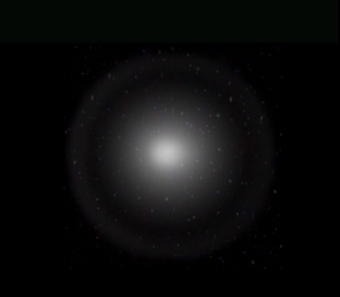|

A nova is a star that suddenly brightens to many times
the magnitude that it formerly was in a short period of time. The crew
of the USS Enterprise-D determined that the star in orbit around Kataan
went nova approximately 1,000 years previously while Captain Jean-Luc
Picard was under the influence of a Kataanian probe. When the star went
nova, it destroyed all life on Kataan. (TNG: "The Inner Light"). When
Doctor Timicin was making experiments on Praxillus to revitalize the
sun he miscalculated some variables on Praxillus went nova. (TNG: "Half
a Life").
A nova is actually a cataclysmic nuclear explosion
caused by the accretion of hydrogen onto the surface of a white dwarf
star. Novae are not to be confused with supernovae, or another form of
stellar explosion. A nova is a cataclysmic binary star that undergoes a
sudden, spectacular brightening, by a factor of up to a million or so,
before dimming to its pre-nova state. Far from being "new" stars, as
the historical name suggests, novae consist of a white dwarf primary in
close orbit around an orange/red dwarf or (in some cases) giant
secondary, the fuel for the outbursts being gas plundered from the
larger star by the white dwarf. In complete contrast with supernovae,
which are one-time events accompanied by the total destruction of a
star, novae leave the host stars essentially intact and capable of
repeating the show. How often a nova recurs, together with the details
of its behavior, determines how it is categorized. There are three main
varieties: classical novae, recurrent novae, and dwarf novae.
A classical nova is characterized by an abrupt
brightening of a thousand-fold to a million-fold (roughly 8 to 15
magnitudes) and the ejection of a shell of matter from the primary
star. As a white dwarf, the primary would normally be a spent force in
terms of making new energy by nuclear fusion, its surface rich in
carbon, nitrogen, and oxygen, which the little star can't burn.
However, thanks to its nearby, hydrogen-rich neighbor, it can
temporarily restock its fusable reserves. Hydrogen flows from the
secondary into an accretion disk around the primary, ad then down onto
the primary's surface. As hydrogen (plus some helium) builds up on the
white dwarf's surface, it compresses and thereby heats up the
underlying material. At some point, a critical temperature, of about 10
million K, is reached in this base layer, at which the overlying
hydrogen-rich layer is caused to ignite. The result is a thermonuclear
runaway that produces a huge surge in luminosity and rips away the
surface material to form a fast-expanding shell.
|
|
